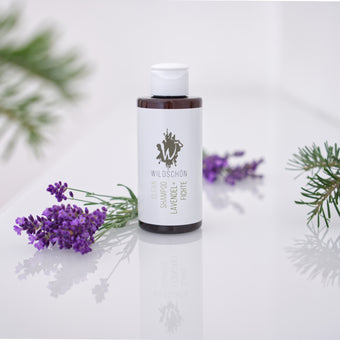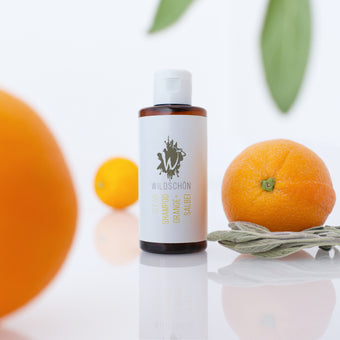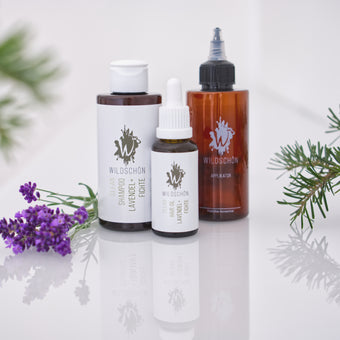Microplastics in cosmetic products: what is it all about?
- What is microplastic and why is it a problem?
- Why are plastics used in conventional cosmetics?
- How you can recognize microplastics in cosmetic products
Microplastics are everywhere: they fly through the air, hide in the ground, float in the water. An estimated 3 million tons of microplastics enter the sea every year. They have already been found in the deepest parts of the oceans, such as in the Mariana Trench, or in the most remote places in Antarctica. At the same time, the smallest parts are floating high in the atmosphere, because the wind can easily transport the fine dust particles for kilometers. Unfortunately, we have to say that microplastics are everywhere - and that's a big problem.
Mic sounds tiny. How small is microplastic actually?
Even if it sounds like it: In most cases, you don't need a microscope to see microplastics. All plastic particles with a diameter of less than 5mm are referred to as microplastics. So there are still some pretty big chunks in there. For various industrial applications, even smaller plastic particles are often used; in this case one often speaks of nanoplastics. So they form a kind of subspecies of microplastics. These particles can be a hundredth or even a thousandth of a millimeter in diameter. Here at the latest you will actually need a microscope to be able to make out the tiny parts.
From textiles to car tires to shampoos: what causes microplastics?
Basically, microplastics can come about in two different ways: either it is produced intentionally due to its special properties (primary microplastics) or it is created when larger pieces of plastic break down or wear off (secondary microplastics). Most of all particulate matter originates on land, from washing synthetic textiles (35%), abrasion from car tires (28%), and urban particulate matter created by all sorts of plastic wear and tear. Residues from cosmetic products only make up about 2% of the microplastics that end up in the sea. That's according to a study by the International Union for Conservation of Nature. Different studies arrive at slightly different numbers, but the dimensions are similar. But microplastics are also created in the sea itself, namely through the decomposition of macroplastics in the water. The large pieces - such as packaging material or fishing nets - are broken down mechanically by wave movements or by UV radiation.
Are microplastics harmful to the environment?
Plastic is commonly made from crude oil, and it is often very difficult to biodegrade. You can learn more about this topic in this article . Once in the environment, it stays there for many years. The small particles can cause particularly great damage in the sea: mussels, worms and fish ingest the microplastic with their food. In this way, the plastic enters the food cycle – and in the worst case even ends up on our plates. But more on that later. First of all, however, the microplastic has a negative impact on the sea creatures themselves. Ingesting plastic can, for example, lead to the formation of tumors or poison the animals with pollutants that can cling to the plastic particles.
Waiter - there is plastic in my mussels...: Is microplastic dangerous?
The plastic particles can get into the body through food. In principle, plastic can contain substances such as certain plasticizers or phthalates, some of which are at least potentially suspected of being carcinogenic, toxic or hormonally active. Due to their surface structure, microplastics also offer chemical free riders a ride. Hydrocarbons, pesticides and other environmental toxins can stick to them and get into the organism via them. Studies show that the smallest microplastic particles were found in the bloodstream of test persons - they do not always migrate completely out of the body via the intestine. Can these particles accumulate in the body and cause diseases? So far, the study situation is still quite thin. Whether the particles can cross the so-called blood-brain barrier and thus get into our thinking organ has not yet been clearly proven. That's not really reassuring though. How big is the problem with cosmetic products in particular? The Federal Institute for Risk Research (BfR) currently assumes that microplastics in cosmetics are not harmful, since the particles are relatively large and cannot be absorbed through the skin. The barrier function of the skin should ensure, at least with these particles, that uninvited visitors stay outside of the body.
What is the point of microplastics in cosmetic products anyway?
Conventional manufacturers of cosmetic products, for example, use the plastic polyethylene to influence the consistency and flowability of their products. The smallest particles from the substance bind the liquid in the products. But the plastics are also used to influence the effect of the product. In peelings, for example, microparticles are used as abrasives that loosen skin flakes and impurities. In make-up, they ensure better adhesion of the products to the skin. Plastic is used in creams, which gives the skin a supposedly smooth surface. Of course, our favorite topic is plastics in hair care: Here, liquid plastics are primarily used in conventional products, which coat the hair and make it easier to comb. In this article you will learn more about silicones in shampoos. As you probably know, we don't think much of it, because we believe that the natural sebum of your scalp and hair oils are far better and more environmentally friendly alternatives - and the sensible way to naturally beautiful hair.

How do I recognize and avoid microplastics in cosmetics and hair care?
Special apps can be of great help in identifying plastic in cosmetics and hair care, for example CodeCheck – an app in which you can also find our products . But a look at the list of ingredients can also provide quick information: If you are familiar with the names of the ingredients, you can make informed decisions. Example: As soon as the word "polymer" appears in the list, you can assume that the product contains plastic. These are some of the common plastics in conventional cosmetics:
- acrylates copolymer
- Acrylate cross polymer
- polyamides
- polyacrylates
- polymethyl methacrylates
- polyquaternium
- polyethylenes
- Polyethylene Glycol
- polyethylene terephthalates
- polypropylene terephthalates
- polybutylene terephthalates
- polypropylenes
- Polypropylene Glycol
- polystyrene
- polytetrafluoroethylene
- polyurethanes
- Silicones, for example cyclotetrasiloxanes, cyclopentasiloxanes or cyclohexasiloxanes
If you don't want to deal with details, you can simply use certified natural cosmetics. The use of petroleum-based substances is generally not permitted in these products. For many small manufacturers, however, the certification process is complex and expensive. For example, our products meet all the requirements of even the strictest natural cosmetics certifications, but we have not yet applied for any because we do not want to pass the costs on to you at the moment and prefer to focus on transparency and information instead.
Are microplastics released from the shampoo bottle into the product?
Studies show that the concentration of microplastics is particularly high in reusable plastic bottles, such as mineral water. Presumably, the surface on the inside of the bottle, which becomes somewhat rougher over time, means that the particles can "hold on". However, shampoo bottles are disposable bottles that are filled under hygienic conditions, so that no significant amounts of microplastic can get into the bottles. The bottles themselves also do not release any particles into the shampoo, so that microplastics are not an issue with natural cosmetic products. However, it is important that you dispose of the bottles correctly so that they do not end up in the environment and become secondary microplastics via the process described above. Therefore, the following applies: plastic bottles must be disposed of in the correct waste (green dot). Then they are fed into the material cycle and are not part of the microplastic problem.
Conclusion: Microplastics in cosmetics are avoidable
Microplastics are a huge problem, to which cosmetics contribute a small but avoidable part. The plastics are added to the products to make them cheaper, to change their properties and to quickly show supposed results in the application. Natural cosmetics have shown for years that it is possible to do without, and more and more consumers are opting for consistently natural products without plastics - for the benefit of the environment and health.









